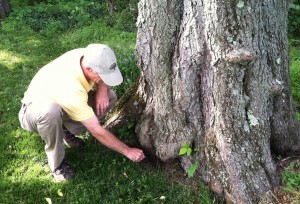Schedule an arborist to inspect your trees now before fall senescence (leaf drop) to develop a winter tree pruning plan.
Dormant season (winter) pruning has many advantages for your trees and is more economical for you — a Win/Win for both you and your trees. But to do it right, you should first inspect your trees in fall.
WHEN To Evaluate Your Trees
 Evaluating trees in fall while they are still leafed-out gives our professional arborists a better overall picture of the health of your important landscape trees.
Evaluating trees in fall while they are still leafed-out gives our professional arborists a better overall picture of the health of your important landscape trees.
Inspecting trees in fall has several advantages:
- Disease, insect feeding patterns and cultural growing conditions can be more accurately assessed.
- Live vs. dead limbs are more easily identified.
- With the additional weight of leaves, necessary clearance to house and infrastructures can be better determined.
WHY To Prune Your Trees
Most tree pruning involves either heading cuts, to shorten branches or redirect their growth, or thinning cuts, to remove entire branches or limbs at their base.
Proper pruning cuts guard against bark tearing, encourage natural healing, and minimize the growth of watersprouts (vigorous-growing vertical shoots that destroy the look of your tree). Thinning out dense interior branches helps improve air circulation, which will reduce disease potential.
Pruning is equal parts science and art and is done to accomplish these goals:
- Promote plant health by removing dead, dying, storm-damaged and diseased limbs, as well as those that rub together or have mechanical damage.
- Encourage flower and fruit development, regenerative growth and maintain density.
- Improve and manage plants’ appearance, size and desired form. We understand how particular trees and shrubs grow and prune to maintain the plant’s naturalistic growth pattern.
- Reduce injury and damage liability by removing potentially hazardous limbs and correcting structural defects.
WHEN To Prune Your Trees
Dormant season (winter) is one of the better times of the year to prune most trees and it can save you money. Here’s why …
- Insects and diseases are dormant which reduces a tree’s exposure and vulnerability while fresh wounds are healing.
- Without leaves, an arborist can move throughout a tree with less interference and there is less time involved in clean up.
- The ground is firmer, causing less soil compaction due to equipment.
- There is less potential disturbance to the ground and nearby perennials.
- Certain tree varieties, like Maples, Birches and Elms have a heavy sap flow in late winter to spring and tend to “bleed” when pruned. This sap loss is mostly water and more of a cosmetic issue than anything, but can be reduced by pruning later in the season.
Call us today at 908-309-6611 to schedule a complimentary autumn tree assessment by one of our Certified Tree Experts and Arborists.
You’ll receive a free written evaluation detailing the health and any necessary pruning recommendations for the important trees on your property.
Or Request an Estimate online.
GET THE LATEST NEWS
Subscribe to the Organic Plant Care Newsletter and get timely and helpful tips and updates monthly.
There's no spam - we promise!





